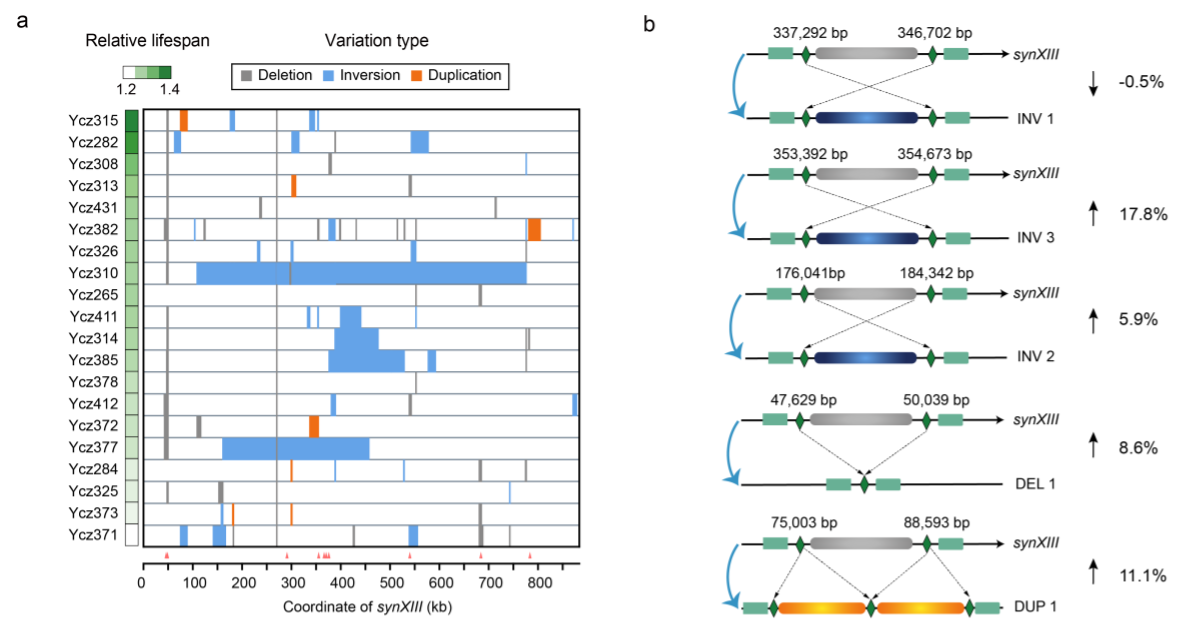As the global population continues to age, there is growing interest in understanding the aging process and developing strategies to delay this process. Identifying the intrinsic mechanisms of longevity and aging is essential for creating effective interventions.
On November 22, a study titled “The de novo design and synthesis of yeast chromosome XIII facilitates investigations on aging,” co-led by BGI-Research and Shenzhen Second People’s Hospital, was published in Nature Communications. The study introduces a novel model for aging research using a synthetic yeast chromosome, synXIII, which was meticulously engineered to enable controlled genomic rearrangements.
 The Study “The de novo design and synthesis of yeast chromosome XIII facilitates investigations on aging” was published in Nature Communications.
The Study “The de novo design and synthesis of yeast chromosome XIII facilitates investigations on aging” was published in Nature Communications.
Saccharomyces cerevisiae (budding yeast) has been served as a model organism for aging research. Previous study has successfully extended yeast lifespan by 82%. However, rapidly identifying genes and pathways associated with lifespan remains a challenge for scientists.
 Design, construction, and characterization of synXIII.
Design, construction, and characterization of synXIII.
This study first de novo designed and constructed a complete chromosome XIII in S. cerevisiae. During this process, researchers observed that when RRN9, an essential gene for the chromosome, was replaced with the synthetic sequence by synonymous codon substitutions, the lifespan of the yeast cells increased. Further investigation revealed that the introduction of the synthetic sequence enhanced gene expression, which led to increased longevity in the yeast strain.
 Synthetic RRN9 exhibits higher expression and promotes lifespan extension.
Synthetic RRN9 exhibits higher expression and promotes lifespan extension.
The SCRaMbLE system (Synthetic Chromosome Rearrangement and Modification by LoxPsym-mediated Evolution) is a unique design of synthetic yeast and could generate a massive mutant library derived from synthetic yeast via controlled genomic rearrangements within the synthetic yeast chromosome XIII (synXIII). Taking the advantage of the SCRaMbLE system, it is possible to screen for long-lived strains from the mutant library.
Using a high-throughput screening approach, which is based on the expression intensity of the aging marker HSP104 and precise lifespan measurements using advanced microfluidic devices, researchers screened 6,000 cells and successfully identified 20 strains with extended lifespans. Despite variations in the genomic sequences of chromosome XIII, these strains exhibited consistent longevity traits. This method accelerates the discovery of genetic targets associated with longevity, providing an effective tool for further exploration of aging mechanisms.

Obtaining Long-lived Yeast Using Synthetic Chromosome XIII Yeast.
Researchers conducted an in-depth analysis of 20 strains displaying longevity characteristics. By screening genes with high mutation frequencies in these strains, they quickly identified genes associated with lifespan regulation. Among these, they selected the longest-living strain, Ycz315, for further analysis. Genome sequencing revealed that five SCRaMbLE rearrangement events occurred on the chromosome XIII of this strain.
To understand how these rearrangements affected lifespan, the researchers reconstructed strains with individual mutations and found that most of these rearranged strains indeed exhibited increased longevity, suggesting that these rearrangements may have a cumulative effect on lifespan extension.
 Genome-wide analysis of 20 lifespan-extended SCRaMbLEants.
Genome-wide analysis of 20 lifespan-extended SCRaMbLEants.
This research not only provides a novel strategy for rapidly generating a wide variety of strains with diverse genotypes and phenotypes but also opens new avenues for aging research and potential therapeutic interventions.
This study can be accessed here: https://www.nature.com/articles/s41467-024-54130-3?utm_source=rct_congratemailt&utm_medium=email&utm_campaign=oa_20241122&utm_content=10.1038/s41467-024-54130-3



